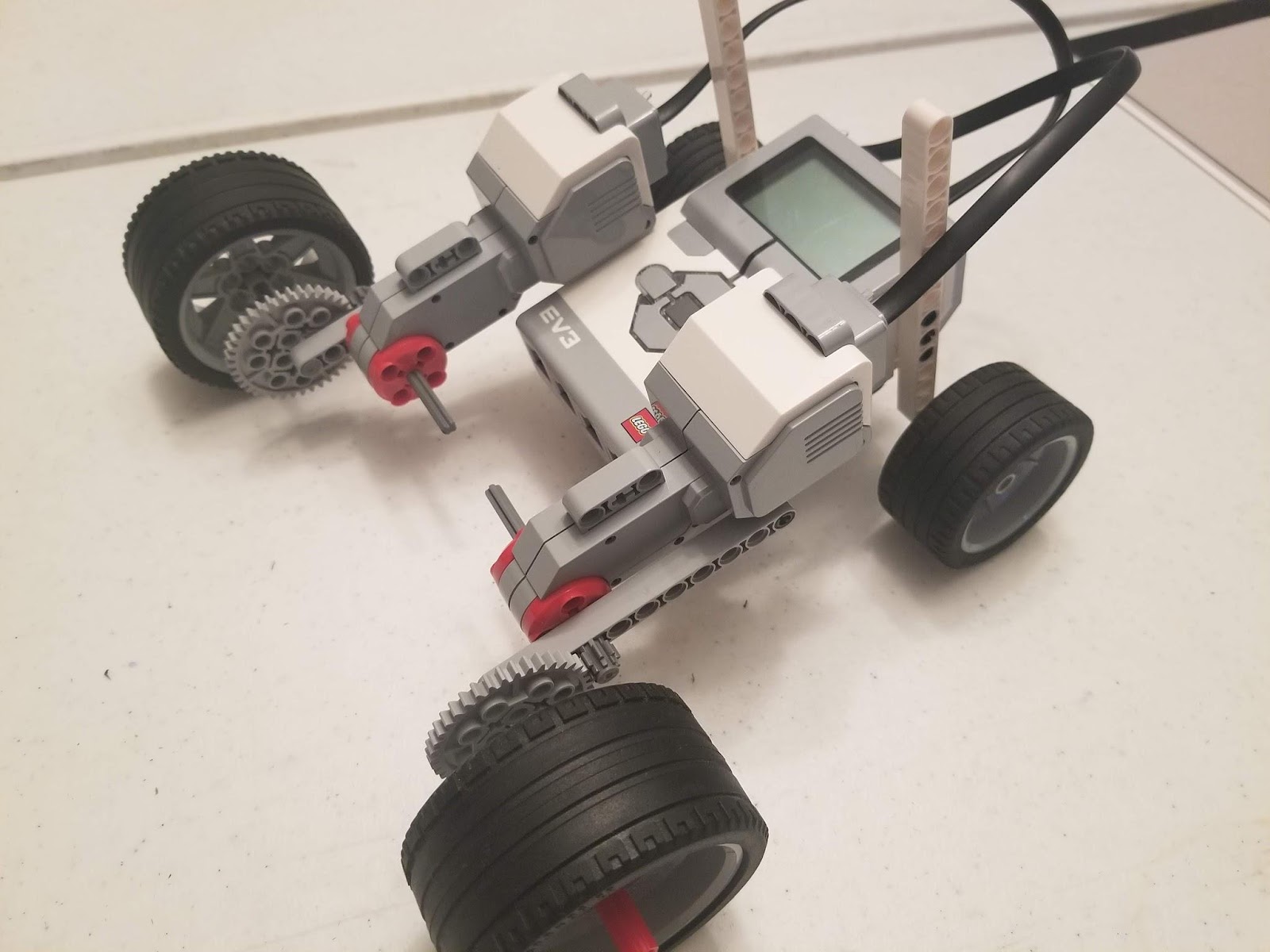What Did We Do?
We started this week’s session with the introduction of the new challenge.
We defined our new challenge as “Design a robotic car that can climb the steepest incline”.
The learning objectives for accomplishing this challenge are to learn and apply the principles of:
Gearing Up and Down
Center of Balance
- (COB) is a point with respect to which the object in question is balanced with respect to applied forces.
Weight Distribution
- Weight distribution is the apportioning of weight within a vehicle, especially cars, airplanes, and trains. Typically, it is written in the form x/y, where x is the percentage of weight in the front, and y is the percentage in the back.
Torque vs. Speed
- Torque is a twisting force that tends to cause rotation.
The Steps
We first let the builders test their original robots on the incline to give us a baseline of the abilities of robots that were designed for other applications. We quickly pointed out that ALL of our robots were able to manage some degree of incline. This gave us the opportunity to then introduce the key elements of succeeding in this challenge. We contrasted our previous designs with the variables of an effective design structure for this specific challenge.
 First, we watched a video on Gearing Up and Down and discussed the trade-off between speed and torque. After that, we quickly discussed the Center of Balance (COB) and how the combination of it with Weight Distribution would help us avoid tipping over AND not sliding on the surface of the incline.
First, we watched a video on Gearing Up and Down and discussed the trade-off between speed and torque. After that, we quickly discussed the Center of Balance (COB) and how the combination of it with Weight Distribution would help us avoid tipping over AND not sliding on the surface of the incline.
One builder quickly used the principles of Gearing Up to make a super fast robotic car. After having fun analyzing how this affected motor output, sound, and traction, we did the right thing and crashed it into everything we could. Then we tested it on the incline. The builder realized right away that we had traded off too much torque for speed when the wheels would not turn on the same incline as our initial trial. We reviewed the concept of Gearing Down to gain torque at the expense of speed and began to make some design changes.
Other builders went through some of the growing pains of figuring out how to implement gears into their drive trains. We discussed different designs and also referred to the extraordinary book “Lego Mindstorms EV3 Idea Book” by Yoshihito Isogawa. This book has invaluable examples of mechanical setups that are useful for all kinds of robotics applications.
We plan to continue in the cycle of Brainstorming, Building Prototypes, Testing, and Analyzing Results at our next meeting, March 29, 2019.
The Challenge Instructions
Ramp Climber
Design and build a car that can climb as steep a ramp as possible.
Engineers repeatedly test their creations and use the results to make improvements to their designs. As you test your car on the ramp, pay attention to what goes wrong–does the car veer to one side, flip over, slide? Noting how the car fails may help you decide what change to try next.
Materials needed
- LEGO pieces for building a motorized one-motor or two-motor car.
- Additional LEGO beams, wheels, and gears
- Board for creating a ramp
- Protractor or app for measuring the ramp’s angle of incline
Notes for the teacher
This activity can be done using MINDSTORMS EV3 or NXT, WeDo, BOOST, or Power Functions motors and battery packs.
To construct the ramp, you will need a sturdy board approximately one-meter long. To make the angle adjustable, you can support the top of the board on a bookshelf, moving the top from shelf to shelf to adjust the angle.
Encourage the students to make only one change at a time and then evaluate it. Many of the students will be tempted to implement several of their ideas at once. Point out to them that it will be much harder to determine the effect of each modification if they have made several changes between trials.
If the students reach a dead end in trying to improve the vehicle, help them to analyze the problems they are encountering. If the wheels slip, they may want to try a different type of tires. If the car stalls in one place, they may want to gear it down to increase torque. If the car tips backward, they may want to lower its center of gravity.
Torque enters into many aspects of this lab. First, the students can increase the torque of their motors by gearing down the cars. Second, increasing the wheel size decreases the force with which the wheel pushes against the ground since the torque of the motor is more-or-less constant and the distance to the point where the force is applied increases with the radius of the wheel. Third, the cars tend to veer sideways as the ramp gets steeper. Mounting the forward wheel(s) well in front of the heavy center part of the car will tend to counteract this tendency by producing a counter-torque.
















